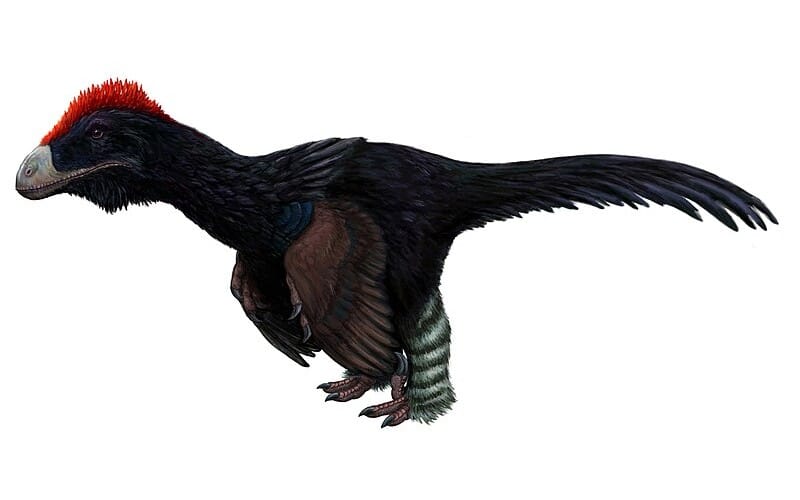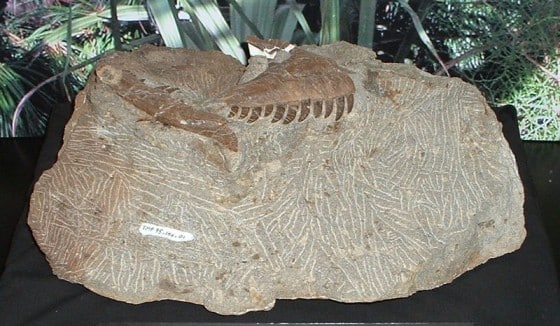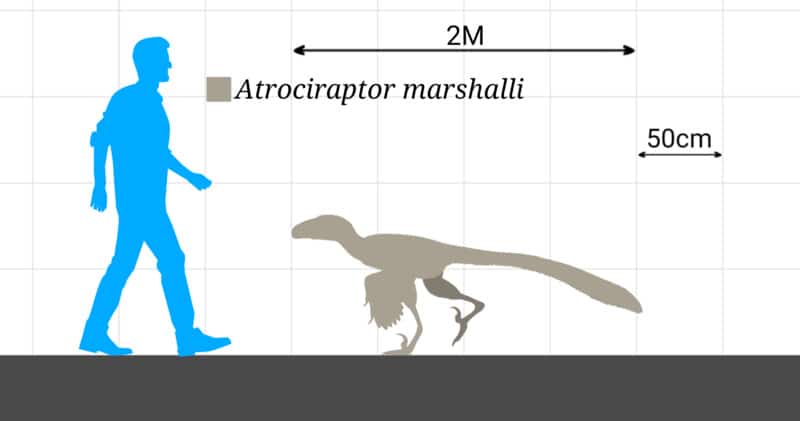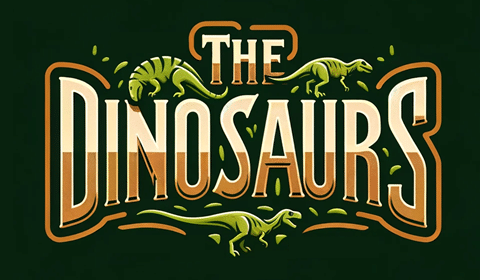Among these prehistoric giants of the Late Cretaceous, there was one particular creature that stood out for its unique characteristics–the Atrociraptor. This dinosaur, whose name means “savage thief,” was a fascinating specimen and its story is one that continues to captivate paleontologists and dinosaur enthusiasts alike.
Atrociraptor Key Facts
| Keyword | Fact |
|---|---|
| Atrociraptor pronunciation | ah-tross-ee-rap-tor |
| Meaning of name | Savage thief |
| Group | Theropod |
| Type Species | Atrociraptor marshalli |
| Diet | Carnivore |
| When it Lived | 70.6 to 66.0 MYA |
| Period | Late Cretaceous |
| Epoch | Early/Lower Maastrichtian |
| Length | Around 6 feet. |
| Height | 1.5-2 feet |
| Weight | 30-35 lbs |
| Mobility | Moved on two legs |
| First Discovery | 1995 by Wayne Marshall |
| Location of first find | Horseshoe Canyon Formation, Alberta, Canada |
| First Described by | 2004 by Philip J. Currie and David Varricchio |
| Holotype | RTMP 95.166.1 |
Atrociraptor Origins, Taxonomy and Timeline

Atrociraptor has a name that sends shivers down the spine, derived from the Latin words ‘atrox’, meaning ‘savage’, and ‘raptor’, meaning ‘seizer’ (thief).
A name fitting for a fast and agile predator, even if it wasn’t much bigger than a medium sized dog, albeit one with a long fluffy tail.
Belonging to the Theropoda group, A. marshalli was a part of the Dromaeosauridae family. Its type species is Atrociraptor marshalli, named after Wayne Marshall, the fossil collector who first discovered it. There are no known subspecies or sister taxa of this dinosaur.
It lived during the Late Cretaceous period, specifically in the Early/Lower Maastrichtian epoch. Its fragmentary fossils were found in western Canada and provided glimpses into the lifestyle and habits of this amazing hunter.
Listen to Pronunciation
Discovery & Fossil Evidence
The Atrociraptor was first discovered in 1995 by Wayne Marshall in the Horseshoe Canyon Formation in Alberta, Canada. It was first described by Canadian paleontologists Philip J. Currie and David Varricchio in 2004.

The holotype consists of parts of the upper and lower jaws, teeth, and numerous small fragments. These fossils have provided invaluable insights into the physical characteristics and lifestyle of this fascinating dinosaur. Later finds of the Atrociraptor have also been made in the same region.
Atrociraptor Size and Description
The Atrociraptor was a carnivorous dinosaur, known for its distinctive physical features. Its body was designed for agility and speed, with a streamlined shape and strong, muscular legs. The head was unusually short and tall, a feature that set it apart from other dinosaurs of its time. Its teeth were relatively straight but they emerged from the tooth sockets at an angle to the jaw line, resulting in a strongly raked row of teeth. This unique dental structure was likely an adaptation for its carnivorous diet.
It had quite a lot of feathers, and its arms were shaped like fully feathered large wings. Its tail would also have had a full set of long feathers, making it look a bit like a velociraptor.
Size and Weight of Type Species

As a relatively small dinosaur measuring approximately 2 meters (6.6 feet) in length, estimated to have weighed around 30-35 lbs. This makes it one of the smaller members of the Dromaeosauridae family. Despite its small size, the Atrociraptor was a formidable predator that used its speed and agility to hunt down its prey.
The Atrociraptor in Detail
The Atrociraptor was a unique dinosaur, with several features that set it apart from other members of the Dromaeosaurid family. One of its most distinctive features was its teeth. Unlike other dinosaurs, the teeth of the Atrociraptor were relatively straight, but they emerged from the tooth sockets at an angle to the jaw line, resulting in a strongly raked row of teeth. This unique dental structure was likely an adaptation for its carnivorous diet.
Another notable feature of this dinosaur was its skull. The skull was unusually short and tall, a feature that set it apart from other dinosaurs of its time. This unique skull shape may have been an adaptation for its hunting lifestyle, allowing it to deliver powerful bites to its prey. The Atrociraptor may have been a small dinosaur but it was still a threatening predator. Its small size and agile body allowed it to move quickly and stealthily, making it a successful hunter.
The Atrociraptor in its Natural Habitat and Environment
It lived in modern day western Canada (likely also in the USA) during the Late Cretaceous period. This was a time when North America was split into Laramidia and Appalachia, two paleocontinents divided by a seaway. Canada at this time was a part of the western continent, Laramidia. The climate was warm and the landscape was dominated by lush vegetation. The Atrociraptor likely lived in a canyon environment, as evidenced by the location of its fossil finds.
As a carnivorous dinosaur, the Atrociraptor was a predator. It likely hunted smaller animals and may have scavenged for food as well. Its diet probably consisted of small mammals, reptiles, and possibly even other dinosaurs.
This was a bipedal dinosaur, meaning it moved on two legs. This mode of locomotion, combined with its small size and agile body, would have made it a swift and efficient hunter. It’s also likely that it had a keen sense of sight and hearing that would have aided it in locating and capturing its prey.
It lived in a time when the Earth was undergoing significant changes. The climate was warm, and the landscape was undergoing constant transformation. Despite, or maybe as a result of these challenges, it was able to adapt and thrive.
Interesting Points about Atrociraptor
- It was a relatively small dinosaur, measuring approximately 2 meters (6.6 feet) in length and weighing around 0.02 tons.
- The teeth were relatively straight, but they emerged from the tooth sockets at an angle to the jaw line, resulting in a strongly raked row of teeth.
- The skull was unusually short and tall, a feature that set it apart from other dinosaurs of its time.
- It was a carnivorous dinosaur, using its nimble speed and agility to hunt down its prey.
- Despite its small size, the Atrociraptor was a significant contributor to the ecosystem of its time, playing a crucial role in the food chain.
Contemporary Dinosaurs
The small but ferocious Atrociraptor shared its world with a number of contemporaries. Among these Laramidian dinosaurs were the Edmontosaurus, Troodon, and Pachyrhinosaurus. Each of these dinosaurs can be compared and contrasted with the Atrociraptor to point out the different ways dinosaurs adapt to their environments and competitors.
The Edmontosaurus was an herbivore of considerable size, but its young may have been a source of sustenance for the Atrociraptor. This dynamic could have added a layer of tension to their coexistence, a constant game of predator and prey. The large herbivore Pachyrhinosaurus was similar. This dinosaur’s distinctive nasal boss and horned frill presents another interesting contrast to the Atrociraptor.
Yet, the Atrociraptor also shared its world with the Troodon, a dinosaur known for its cunning. The Troodon could have posed a challenge due to its intelligence and agility, adding another dimension to the Atrociraptor’s existence.This coexistence of different species, both similar and entirely different, paints a vivid picture of the Atrociraptor’s world–a testament to the diversity and complexity of life in prehistoric times.
Frequently Asked Questions
The name means “savage thief,” derived from the Latin words ‘atrox’, meaning ‘savage’, and ‘raptor’, meaning ‘seizer’.
It lived during the Late Cretaceous period, specifically in the Early/Lower Maastrichtian epoch, around 70.6 to 66.0 million years ago.
As a carnivorous dinosaur, it likely hunted smaller animals and possibly scavenged for food as well. Its diet likely consisted of small mammals, reptiles, and possibly even other dinosaurs.
The first fossil find was discovered in the Horseshoe Canyon Formation in Alberta, Canada.
Some unique features include its relatively straight teeth that emerged from the tooth sockets at an angle to the jaw line, and its unusually short and tall skull.
This was a relatively small dinosaur, measuring approximately 2 meters (6.6 feet) in length and weighing around 0.02 tons.
Sources
- https://lesdinos.free.fr/003%202004.pdf
- https://www.jstor.org/stable/20490961
- https://digitallibrary.amnh.org/handle/2246/6570
- https://www.researchgate.net/publication/263891965_Dromaeosauridae_Dinosauria_Theropoda_from_the_Bissekty_Formation_Upper_Cretaceous_Turonian_of_Uzbekistan_and_the_phylogenetic_position_of_Itemirus_medullaris_Kurzanov_1976
- https://journals.plos.org/plosone/article?id=10.1371/journal.pone.0093190
Article last fact checked:Joey Arboleda, 12-24-2024
Featured Image Credit: FunkMonk (Michael B. H.), CC BY-SA 3.0 , via Wikimedia Commons
